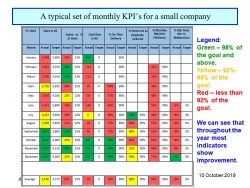This article is not about momentary misjudgments or wrong decisions made on the spur of the moment. It is about mistakes which are made by CEOs who are driven by approaches that, in my opinion, are incorrect and can cause substantial negative impact on business results.
Mental Fixation
A friend once told me that he started his “Creative thinking” lectures by asking his audience to take off their wrist watches and wear them on the other arm. He explained that creativity begins with letting go of familiar habits.
Our mental fixation begins with clinging to the familiar. We tend to prefer the things we are used to and know well. We are in no hurry to change our views especially when we form our opinions.
Creative thinking requires breaking away from our comfort zone.
Owners of previously successful companies are unwilling to acknowledge the fact that the business environment has changed. They fail to realize that they are no longer protected by the law on trade levies and protective measures, that the local market has opened to outside competition, and they have new competitors. One of the main reasons companies remain small or medium size is the CEOs’ inability to change their business concept.
Streamline suggestions, forwarded by employees, may provide good opportunities for companies to adjust. These suggestions are proposed by people who think differently and look at the general picture in a new way. They can offer a real chance for the company to change.
However, few companies know how to encourage their employees to submit streamline suggestions. The majority do not.
Let us imagine a situation in which a chief technologist or the company’s engineer discuss an optimization proposal submitted by one of the employees.
They might see it as a threat to their status. They may think that if an “ordinary” employee can think of ideas they had not thought themselves, “what does it say about them? Maybe it is a reflection on their insufficient knowledge? Maybe someone will conclude they are no good at their jobs”? They will, almost certainly, try to find faults in the suggestion and reasons to reject it.
In short, our mental fixation is a real threat to the company’s ability to develop. It prevents changes and ongoing adjustments to the ever-changing business environment.
Operating without monitoring performance
Most companies I know define major goals, but only a few define personal objectives to their employees. This is one of the biggest, most common mistakes CEOs make. It makes it difficult to achieve the goals.
How does your company operate? Do you define personal objectives? Is compliance with these objectives regularly monitored?
To achieve its goals, a company must define personal, measurable targets aimed at achieving the major goals. These targets must be reviewed on a regular basis to guarantee the goals are fully achieved.
The goal of most businesses is to increase profit. To achieve this, CEOs usually set monthly targets. For example: sales targets, production targets, on time delivery targets etc. However, to meet the goal, the CEO must also regularly review if and how the targets are met. The review should be performed at monthly management meetings, during which each manager presents the personal objectives they have achieved, those they failed to achieve, and how they plan to achieve them. Operational targets and often sales targets should be discussed every day.
Furthermore, managers must meet once a week with their team members to review the objectives and discuss the action plans to achieve all targets. Short and focused daily meetings must also be held between managers and workers, to follow up on the daily objectives and discuss daily actions to improve performance.
What about the relative advantage of the human resource?
Highly motivated employees, who are committed to their work and strive to achieve the company’s goals, are the competitive advantage of every firm. Those employees will enable every company to lead the competition, improve profit and withstand hard times.
How many companies in this situation do you know?
Engaging employees and connecting them to the company’s goals require recognizing their importance and contribution. To do that, a company must employ a senior Human Resource manager.
I wrote about the importance of HR managers in my blog last week. Not to repeat myself, I would only mention Jack Welch, General Electric CEO for 20 years, who said in his book “Winning” that there is no doubt that the human resource manager should be the second most important person in any organization. From the CEO’s point of view, he added, the HR manger should be as equally important as the chief financial manager.
Welch said the above when speaking to an audience of five thousand male and female human resource managers. When he said it, he recalled, there was a strange silence in the hall and in fact there was a heavy stillness […] Is this what happens in your company […]? he asked his audience. He then asked his audience to raise their hands if they were employed in a company where the CEO respected the HR manager the same way he respected the chief financial manager. Fifty hands were raised. Out of five thousand. […] It seems that, unintentionally he stepped on the toes of 99% of the audience, he concluded.
Welch’s book was written in 2005, almost twenty years ago. What has happened since then? I would estimate that only a few of the readers know companies in which the HR manager and the chief financial manger are equally respected by the CEO.
No innovation and a constant search for a Blue Ocean
Many firms start at a point in which they have a competitive advantage in the product or service they provide. However, over time, competition develops, and the competitive edge erodes, even if protected by a patent. When a company has no innovations to offer it focuses on low pricing, which is a red ocean strategy.
A company who bases its competition on low pricing, might close its business in just a few years because there will always be another company, based in Vietnam or a similar location, who will offer lower prices.
Innovations don’t just happen. They don’t appear from nowhere. When Toyota decided to develop the G21, car of the 21st century, (which later became the Prius Hybrid car) the company nominated, a "non-expert chief engineer", Mr. Takeshi Uchiyamada, head of project. Mr. Takeshi Uchiyamada had never headed such a project before. He was free of any concept regarding developing a new vehicle.
Toyota did not invest in innovation because they were big and successful. They became big and successful because they invested in innovation, and they are not the only ones.
Essilor Luxottica purchased Shamir Optical Industry Ltd. because of its innovation. about a year ago, during the Shamir Optical industry’s fiftieth anniversary, I learnt that 15% of Shamir Optical Industry’s employees are working at the Research and Development department.
Investment in innovation always pays off. It is a mistake to set it aside.
No Transparency
Many managers play their cards close to their chest and avoid providing information to the employees.
Not sharing information with employees is another mistake many CEOs make because the more information employees receive, the more they develop a sense of belonging and a will to contribute to the company’s success.
One of the first issues employees brought up in conversations I had with them was the issue of transparency; how much it is appreciated and how much they value every piece of information they receive.
It is true that some information is confidential. However, confidential information should be limited to development plans, trade agreements, customer’s names, and personal data of employees.
Public companies (traded on the stock exchange) publish quarterly information in the media. This does not prevent them from maintaining their success.
Concealing information is practiced mainly by small to medium size family businesses. It is the wrong thing to do, because when the company withholds information from its employees, the employees withhold information from the company. It’s a two-way street.
Summary and recommendations
Every company operates in its own, unique way. However, the majority share the same characteristics and the same ways to achieve accomplishments or experience failures. It follows that many CEOs make similar mistakes.
Success at a certain point in time does not mean that all management decisions were correct and that no, potentially harmful, mistakes had been made along the way.
Jim Collins and Morton T. Hansen, define three conditions for success in their book 'Great by Choice'. One of the conditions is that the company keeps excellent business results, relative to the stock market and its direct competition, over at least fifteen consecutive years. The book presents examples of seemingly successful companies that collapsed. Success can, therefore, only be measured over time.
The five fundamental, most common mistakes are:
- Mental fixation
- Missing targets and poor follow up on performance
- Failing to appreciate the relative edge of the human resource
- No innovation
- No transparency












 My First Book: Manage! Best Value Practices for Effective Management
My First Book: Manage! Best Value Practices for Effective Management